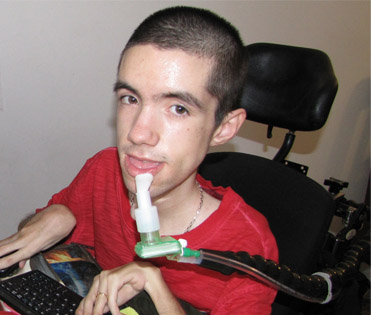
Brandon McCarthy takes charge of his breathing needs with easy access to his mouthpiece held by the CANVent Arm.
The Canadarm used on the International Space Station may be more famous, but TOH’s CANVent Arm is quietly gaining its own recognition and respect.
Mounted on a person’s wheelchair, the inexpensive mouthpiece, circuitry and Loc-Line modular hose that form the CANVent Arm help patients with neuromuscular disorders and spinal cord injuries breathe more easily on their own, reducing the risk of serious life-threatening respiratory complications.
The CANVent (Canadian Alternatives in Non-invasive Ventilation) program at TOH Rehabilitation Centre also helps identify patients in the community who are at risk for complications and provide preventative treatment in order to avoid going to the hospital.
“We provide critical support to patients who would otherwise require emergency visits or critical care admissions as a result of something as simple as an upper respiratory tract infection,” said Dr. Douglas McKim, who leads the program.
The respiratory therapists working in this specialized unit provide care and disease management strategies for patients who have weak breathing and coughing muscles due to spinal cord injuries, neuromuscular disorders (such as muscular dystrophy, amyotrophic lateral sclerosis, multiple sclerosis), or other lung conditions (such as chronic obstructive pulmonary disease).
“The CANVent program has saved a significant number of health-care dollars while enhancing the quality of life and survival of patients with respiratory illnesses in the Champlain LHIN and beyond,” said Carole LeBlanc, Charge Registered Respiratory Therapist.
The program has attracted dozens of invitations for presentations and speaking engagements across Canada and internationally. More importantly, the approach to care pioneered by the CANVent program has been adopted by many Canadian health-care authorities as well as internationally.
The arm was developed through the combined efforts of respiratory therapists at TOHRC, including Rehabilitation Engineering, and the London Health Sciences Centre.

Support patient care and research at
The Ottawa Hospital


 To reset, hold the Ctrl key, then press 0.
To reset, hold the Ctrl key, then press 0.